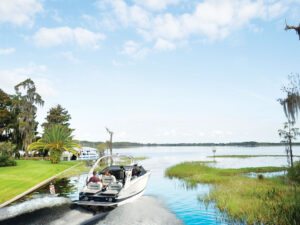Capt. Billy Tyne has lost his antennas and most of his fishing gear. A swinging steel “bird,” used to ease the boat’s rolling, has taken out the port pilothouse window so the sea comes pouring in each time a wave breaks over the boat – which is happening far too often. Things are looking grim, so he’s thinking about turning and making a run for it. Bad choice, Billy. On the screen, Tyne is being ground into chum between two rough-toothed gears, the combining maelstroms that will come to be known as The Perfect Storm. He’s beat up, and it’s easy to understand why he’d try something desperate like turning in 70-footers, seas with faces one and a half times as long as the 72′ Andrea Gail. If ever a maneuver demands finesse, this is it.
Tyne, probably never a man with good timing to start with, will have to execute this one perfectly. We hear him say, “Boys, that’s it. We can’t make it. We’re turning around. It’s going to be the turnaround of all time. Textbook. So get ready.”
As a fisherman in Sebastian Junger’s book puts it, “Seventy-foot seas – I’d be puttin’ on my diapers at that point.” Hell, I’ve done it in 20-footers and needed Pampers over my ultra-absorbent Depends. In the movie, Tyne’s right when he says, “We’ve only got one chance at this. So pray.” Amen.
Halfway through the turn, they get caught broadside, turn turtle, come up to surf down a wave at 12 knots, pile drive into the back of another wave, and submarine in until the Andrea Gail’s high bow slowly brings it back up. The crew screams and pounds each other, “We’re alive, we made the turn, we did it.” Only in the movies.
In real life, if you get caught out in short steep seas, slow down and take them bow-to, letting the waves pass under you. In high rolling seas, you can run with them if you keep your speed to a minimum, trying not to surf down a wave or get kicked in the butt. Square-sterned boats can get pushed by a wave, burying the bow so it slews around – broaching – out of control with the rudder useless in air or foam.
If you decide to turn and run, wait. Watch for patterns. Waves don’t march lined up like obedient soldiers. They’re unruly, piling up on the backs of each other. This makes for a pattern of larger waves followed by a comparative lull. The bigger ones are easier to spot, coming every one to two minutes apart.
Once you recognize the pattern, plan to start your turn after the biggest wave has passed so those that follow will be on a downward trend.
Crank the wheel hardover as you pass over the crest. On long-keeled boats, such as trawlers, start turning when the bow is hanging in the air. This makes the boat easier to spin, as less of it is in the water. If you have a right-hand prop, turning to port is usually easier and faster. Hit the throttle, let the boat build some speed, then turn the wheel. A fast planing boat may be able to make a complete 180 before the next wave, but most cruisers won’t. So divide the turn into two maneuvers. First, angle the boat to about 50 degrees off the wind and hold this for a wave, then as the next crest passes, make the final turn. Straighten out quickly and keep the seas dead astern.
These turns are tricky and, as with Tyne, you get only one chance. For me, when seas are running like that, I’d either want to be in the audience or in port. Best leave the impossible to Hollywood pros, who can keep trying until they run out of stunt doubles.









